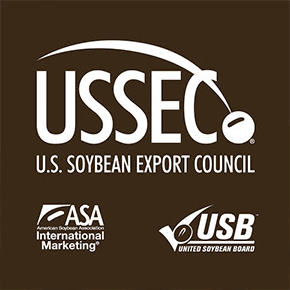The Earth's population is currently at approximately 7 billion. The population is estimated to reach 9 billion by 2050. In order to sustain food sources for 9 billion people with Earth's limited resources, it is necessary not only for producers, but also companies and consumers to come full circle and promote sustainable production.
Four GoalsU.S. soybeans have clear target goals and a supply that will be stable and sustainable over the long term is being worked toward.
-
Effects of Land Use Improved 0 % Improved 7.4% from 2000 to 2010.
Aiming at a 10% improvement over the next 10 years. -
Energy Efficiency Improved 0 % Improved 17.9% from 2000 to 2010.
Aiming at a 10% improvement over the next 10 years. -
Soil Erosion Reduced 0 % Reduced 9.9% from 2000 to 2010.
Aiming at a 25% reduction over the next 10 years. -
Total Emissions of Greenhouse Gasses Reduced 0 % Reduced 9.1% from 2000 to 2010.
Aiming at a 10% reduction over the next 10 years.
Sustainability Through the Numbers
Every day and every year, U.S. soybean producers are engaged in countless sustainable production activities.
They are constantly working on improving sustainability for the future.
-
Crop Rotation
Out of the total area of planted U.S. soybeans, 94% of the land is rotated, contributing to an improvement in biodiversity.
-
Reduced Tillage Farmi
Out of the total area of planted U.S. soybeans, 70% use conservation tillage methods, such as no-till farmland.
-
Water Management
94% of U.S. farm use non-irrigated cultivation methods.
-
Insect Pest Management
95% of U.S. soybean producers perform a field survey each season for pest control.
-
Nutrient Management
U.S. soybean producers perform surveys of soil conditions to maintain appropriate nutrient levels in the soil.
-
Conservation
10% of U.S. farmland is allowed to rest uncultivated in order to protect areas vital to environmental conservation.
【参照】
Crop Rotation:USDA Economic Research Service (ERS) • Water Management:USDA Ag Census 2012 • Reduced Tillage Farmi:USDA National Agricultural Statistics Service (NASS) • Insect Pest Management:Best Practices Report, United Soybean Board, October 2014 • Nutrient Management:Best Practices Report, United Soybean Board, October 2014 • continuous detail of records:USDA Natural Resources Conservation Service (NRCS) • Conservation:USDA FSA





